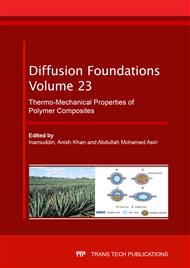[1]
L.O. Vasquez, Fuel Cell Research Trends, Nova Science Publishers, Inc., New York, (2007).
Google Scholar
[2]
N. Angulakshmi, S. Thomas, K. S. Nahm, A. M. Stephan, R.N. Elizabeth, Electrochemical and mechanical properties of nanochitin-incorporated PVDF-HFP-based polymer electrolytes for lithium batteries, Ionics. 17 (2011) 407–414.
DOI: 10.1007/s11581-010-0517-z
Google Scholar
[3]
P.N. Pintauro, Perspectives on Membranes and Separators for Electrochemical Energy Conversion and Storage Devices, Polym. Rev. 55 (2015) 201-207.
DOI: 10.1080/15583724.2015.1031378
Google Scholar
[4]
D.T. Hallinan, N. P. Balsara, Polymer electrolytes, Annu. Rev. Mater. Res. 43 (2013) 503–525.
DOI: 10.1146/annurev-matsci-071312-121705
Google Scholar
[5]
N. Sykam, R.K. Gautam, K.K. Kar, Electrical, mechanical, and thermal properties of exfoliated graphite/phenolic resin composite bipolar plate for polymer electrolyte membrane fuel cell, Polym. Eng. Sci. 55 (2015) 917–923.
DOI: 10.1002/pen.23959
Google Scholar
[6]
S. Lee, K. Yoon, M. Song, H. Peng, K. A. Page, C. L. Soles, D. Y. Yoon, Structure and Properties of Polymer Electrolyte Membranes Containing Phosphonic Acids for Anhydrous Fuel Cells, Chem. Mater. 24 (2012) 115−122.
DOI: 10.1021/cm202064x
Google Scholar
[7]
M. H. D. Othman, A. F. Ismail, A. Mustafa, Recent Development of Polymer Electrolyte Membranes for Direct Methanol Fuel Cell Application – A Review, Malaysian Polymer Journal. 5 (2010)1-36.
Google Scholar
[8]
H. Zhang, P. K. Shen, Recent Development of Polymer Electrolyte Membranes for Fuel Cells, Chem. Rev.112(2012) 2780−2832.
DOI: 10.1021/cr200035s
Google Scholar
[9]
J. Hou, H.Yu, L.Wang, D. Xing, Z. Hou, P. Ming, Z. Shao, B. Yi, Conductivity of aromatic-based proton exchange membranes at subzero temperatures, J. Power Sources. 180 (2008) 232–237.
DOI: 10.1016/j.jpowsour.2008.01.052
Google Scholar
[10]
S. U. Çelik, A. Bozkurt, S. S. Hosseini, Alternatives toward proton conductive anhydrous membranes for fuel cells: Heterocyclic protogenic solvents comprising polymer electrolytes. Prog. Polym. Sci. 37 (2012) 1265–1291.
DOI: 10.1016/j.progpolymsci.2011.11.006
Google Scholar
[11]
U. Sen, A. Bozkurt, A. Ata, Nafion/poly(1-vinyl-1,2,4-triazole) blends as proton conducting membranes for polymer electrolyte membrane fuel cells. J. Power Sources 195 (2010) 7720–7726.
DOI: 10.1016/j.jpowsour.2010.04.087
Google Scholar
[12]
E. Montoneri, V. Boffa, S. Bottigliengo, M. Casciola, M. Sganappa, A. Marigo, G. Speranza, L. Minati, S. Torrengo, G. Alberti, L. Bertinetti, A new polyfunctional acid material for solid state proton conductivity in dry environment: Nafion doped with difluoromethandiphosphonic acid. Solid State Ionics 181 (13–14) (2010) 578–585.
DOI: 10.1016/j.ssi.2010.03.001
Google Scholar
[13]
N. W. DeLuca, Y. A. Elabd, Polymer electrolyte membranes for the direct methanol fuel cell: A review, J. Polym. Sci. Part B Polym. Phys. 44 (2006) 2201–2225.
DOI: 10.1002/polb.20861
Google Scholar
[14]
J. Tang, W. Yuan, J. Wang, J. Tang, H. Li, Y. Zhang, Perfluorosulfonate ionomer membranes with improved through-plane proton conductivity fabricated under magnetic field, J. Membr. Sci. 423–424 (2012) 267–274.
DOI: 10.1016/j.memsci.2012.08.023
Google Scholar
[15]
G. G. Kumar, Irradiated PVdF-HFP-montmorillonite composite membranes for the application of direct ethanol fuel cells, J. Mater. Chem., 21 (2011) 17382–17391.
DOI: 10.1039/c1jm11528f
Google Scholar
[16]
G. Merle, S.S. Hosseiny, M. Wessling, K. Nijmeijer, New cross-linked PVA based polymer electrolyte membranes for alkaline fuel cells, J. Membr. Sci., 409–410 (2012) 191–199.
DOI: 10.1016/j.memsci.2012.03.056
Google Scholar
[17]
Y. Iwai, T. Yamanishi, Thermal stability of ion-exchange Nafion N117CS membranes. Polym. Degrad. Stab. 94 (2009) 679–687.
DOI: 10.1016/j.polymdegradstab.2008.12.020
Google Scholar
[18]
L.H. Sperling, Introduction to Physical Polymer Science, fourth ed., Wiley-Interscience, Hoboken, NJ, (2006).
Google Scholar
[19]
X. Fang, P. K. Shen, S. Song, V. Stergiopoulos, P. Tsiakaras, Degradation of perfluorinated sulfonic acid films: An in-situ infrared spectro-electrochemical study, Polym. Degrad. Stabil. 94 (2009) 1707–1713.
DOI: 10.1016/j.polymdegradstab.2009.06.015
Google Scholar
[20]
H. T. Li, G. Zhang, W. J. Ma, C. J. Zhao, Y. Zhang, M. M. Han, J. Zhu, Z. G. Liu, J. Wu, H. Na, Composite membranes based on a novel benzimidazole grafted PEEK and SPEEK for fuel cells, Int. J. Hydrogen Energy 35 (2010) 11172–11179.
DOI: 10.1016/j.ijhydene.2010.07.091
Google Scholar
[21]
J. Peron, A. Mani, X. Zhao, D. Edwards, M. Adachi, T. Soboleva, Z. Shi, Z. Xie, T. Navessin, S. Holdcroft, Properties of Nafion® NR-211 membranes for PEMFCs, J. Membr. Sci., 356 (2010) 44–51.
DOI: 10.1016/j.memsci.2010.03.025
Google Scholar
[22]
S. Zhang, X.-Z. Yuan, J.N.C. Hin, H. Wang, J. Wu, K.A. Friedrich, M. Schulze, Effects of open-circuit operation on membrane and catalyst layer degradation in proton exchange membrane fuel cells, J. Power Sources, 195 (2010) 1142–1148.
DOI: 10.1016/j.jpowsour.2009.08.070
Google Scholar
[23]
M. Rikukawa, K. Sanui, Proton-conducting polymer electrolyte membranes based on hydrocarbon polymers, Prog. Polym. Sci. 25 (2000) 1463-1502.
DOI: 10.1016/s0079-6700(00)00032-0
Google Scholar
[24]
M. Yoshitake, A. Watakabe, Perfluorinated ionic polymers for PEFCs (including supported PFSA), in Fuel Cell Handbook-I, Ed. Scherer, G.G., Advances in Polymer Science, Springer-Verlag, Germany, 2008, p.127–155.
DOI: 10.1007/12_2008_154
Google Scholar


